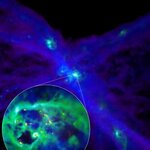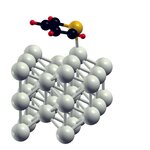Physics

Researchers at Low Temperature Laboratory and Laboratory of Physics (TKK) and at University of Stony Brook (New York) have potentially solved the problem of accurately defining the ampere. The group has developed a frequency to current converter, the accuracy of which is based on the known charge of an electron and the extreme accuracy in defining frequency. The nanodevice is essentially a single electron transistor which works as a simple single-electron turnstile. Its best performance is achieved at very low temperatures.
Previously, the electric current and its unit, the ampere, have been…

Their day job is to keep trees upright but the forest's tiniest building blocks could soon be on their way into future products. Imagine a packaging material that also kills bacteria. Or a disposable duvet cover that keeps infection away when you are in a hospital bed.
Scientists in Trondheim believe that exciting new products can be created if we make use of some of nature's tiniest construction materials. They are called “fibrils” and you may never have heard of them, but there are millions of them in each piece of paper you hold.
A wonder of nature
Fibrils form continuously in all growing…

It has been 35 years since humans last walked on the moon, but there has been much recent discussion about returning, either for exploration or to stage a mission to Mars. However, there are concerns about potential radiation danger for astronauts during long missions on the lunar surface.
A significant part of that danger results from solar storms, which can shoot particles from the sun to Earth at nearly the speed of light and can heat oxygen in the Earth's ionosphere and send it in a hazardous stream toward the moon.
Earth is largely protected by its magnetic field, or magnetosphere, but…

Imagine you are sitting around a campfire. If you move closer to the fire you get hotter. If you move awayy ou get cooler. Pretty basic, right?
Our closest star, the sun, doesn't follow those rules. As you move away from the solar surface, into the sun's outer atmosphere (the corona) it actually gets a lot hotter before it cools off. The solar surface is about 10,000 degrees Fahrenheit, while temperatures in the corona soar to millions of degrees.
Although scientists have some ideas of what might heat the solar corona, there is no universally accepted explanation. Many mechanisms might…

Measuring soot formation in a diesel engine is far from easy because the turbulent environment in the combustion cylinder means no two combustion cycles are the same. Furthermore, the measurements are difficult to reproduce as the pressure at which fuel is injected into the cylinder causes an extra source of turbulence.
Bas Bougie, a doctoral candidate at Radboud University Nijmegen created a glass cylinder with an engine so he could investigate soot formation and find ways to optimize diesel performance using laser light.
Laser Induced Incandescence (LII) can be used to investigate optimal…
It’s a rare case of all light and no heat: A new study reports that a laser can be used to switch a film of vanadium dioxide back and forth between reflective and transparent states without heating or cooling it.
It is one of the first cases that scientists have found where light can directly produce such a physical transition without changing the material’s temperature.
It is also among the most recent examples of “coherent control,” the use of coherent radiation like laser light to affect the behavior of atomic, molecular or electronic systems. The technique has been used to control…

Faint, fleeting blue flashes of radiation emitted by particles that travel faster than the speed of light through the atmosphere may help scientists solve one of the oldest mysteries in astrophysics.
For nearly a century, scientists have wondered about the origin of cosmic rays — subatomic particles of matter that stream in from outer space. “Where exactly, we don’t know,” said Scott Wakely, Assistant Professor in Physics at the University of Chicago. “They’re raining down on the atmosphere of the Earth, tens of thousands of particles per second per square meter.”
Recent results from the…

Researchers using supercomputer simulations have exposed a very violent and critical relationship between interstellar gas and dark matter when galaxies are born – one that has been largely ignored by the current model of how the universe evolved.
The findings, published today in Science, solve a longstanding problem of the widely accepted model – Cold Dark Matter cosmology – which suggests there is much more dark matter in the central regions of galaxies than actual scientific observations suggest.
“This standard model has been hugely successful on the largest of scales—those above a few…

The van der Waals force, a weak attractive force, is solely responsible for binding certain organic molecules to metallic surfaces. In a model for organic devices, it is this force alone that binds an organic film to a metallic substrate. This data, recently published in Physical Review Letters, represents the latest findings from a National Research Network (NRN) supported by the Austrian Science Fund FWF. These findings mean that numerous calculation models for the physical interactions between thin films and their carrier materials will need to be revised.
Although they fulfil complex…

University of Wisconsin-Madison researchers are taking a leadership role in the quest for one of Einstein’s greatest predictions – gravitational waves.
“Galileo was the first person to use the telescope to view the cosmos,” says Patrick Brady, a UWM professor of physics. “His observations with the new technology led to the discovery of moons orbiting Jupiter and lent support to the heliocentric model of the solar system.”
Gravitational waves are produced when massive objects in space move violently. The waves carry the imprint of the events that cause them. Scientists already have indirect…